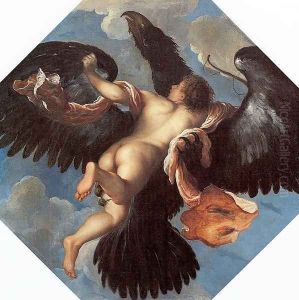Damiano Mazza Paintings
Damiano Mazza is a somewhat elusive figure in the panorama of Italian Renaissance art, primarily known for his connections to the city of Padua and the broader Veneto region during the late 16th century. Not much is known about his early life, including his exact birth and death dates, which remain a matter of speculation among art historians. Mazza's work, however, suggests that he was deeply influenced by the Venetian school of painting, which was characterized by its vibrant color palette and emphasis on light effects.
Mazza is often mentioned in connection with the great Renaissance master Paolo Veronese, under whom he is believed to have studied or at least been significantly influenced. This association is evident in Mazza's approach to composition and his handling of color, which echo the grandeur and luminosity typical of Veronese's work. Despite the scarcity of documented works attributed directly to Mazza, those that are, exhibit a profound understanding of human anatomy, a keen eye for detail, and a penchant for incorporating classical themes with a contemporary sensibility.
His contributions to the art world are most notable in religious and mythological paintings, where his talent for narrative and allegory shines through. Unfortunately, the absence of comprehensive records has led to many of his works being either lost to history or attributed to other artists of the time. This lack of recognition has somewhat obscured Mazza's place in art history, leaving a figure that, while influential in his time, remains on the periphery of the Renaissance's celebrated legacy.
Despite these challenges, recent scholarship has begun to shed more light on Damiano Mazza's oeuvre, with art historians and conservationists working to correctly attribute his works and reassess his impact on the Italian Renaissance. Through these efforts, Mazza is gradually being acknowledged as a significant, if underappreciated, artist who contributed to the richness and diversity of 16th-century Italian art. His story is a compelling example of the many talented individuals whose contributions have been overshadowed by the era's more famous names but whose work nonetheless played a crucial role in the development of European art.
